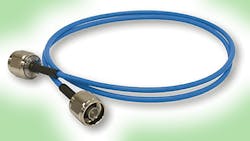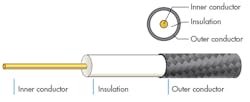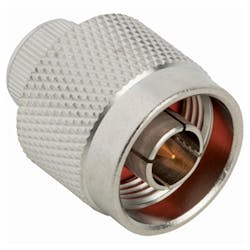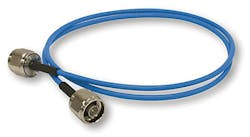This file type includes high resolution graphics and schematics when applicable.
Cables and connectors are often overlooked in the course of designing a high-frequency system. Specifiers typically consider basic requirements—including frequency range, insertion loss, impedance, power-handling capability, and even length and diameter—but a number of other cable/connector characteristics can impact system performance. Not all cables, connectors, and cable assemblies are the same, and knowing the differences can help secure optimum interconnection components for a particular application.
Proper design practices will treat cables and connectors as any other component in a high-frequency system. Cables and connectors are specified by frequency range and numerous other performance parameters, like insertion loss, power-handling capability, and voltage standing wave ratio (VSWR). Many cables, connectors, and cable assemblies appear to be relatively simple mechanical structures. Nevertheless, the various junctions between cables and connectors and within connectors represent opportunities for impedance mismatches and signal reflections, leading to performance degradation. Achieving high performance levels from any cable and connector requires sound mechanical design and reliable manufacturing processes capable of delivering repeatable, tight mechanical tolerances.
Cables and connectors for RF/microwave applications are designed for a characteristic impedance of 50 Ω, in contrast to the 75-Ω cables and connectors used for video and broadcast applications. The 50-Ω impedance represents a compromise between the characteristic impedance of a low-loss air-filled coaxial line at 77 Ω and maximum power transfer at 30 Ω.1
Cable types have expanded over the years from just rigid, semi-rigid, and flexible coaxial varieties. Present-day versions embody some characteristics of both flexible and semi-rigid cables. Formable cables, for instance, boast performance levels approaching those of semi-rigid cables in terms of attenuation and phase stability, yet can be formed into required shapes and forms without special tools.
In general, the price of flexibility in coaxial cables is some sacrifice in electrical performance, with rigid and semi-rigid cables typically providing the best amplitude and phase performance of the cable types. For example, flexible cables fabricated with braided outer shields have been known to suffer performance anomalies when cables are kinked or tightly bent, especially at higher frequencies. Cables with solid outer shields tend to provide more consistent performance and better shielding for applications operating under conditions of electromagnetic interference (EMI). Cables with special materials have also been developed to provide phase and temperature stability for measurement applications, such as with a vector network analyzer (VNA).
Two-conductor RF/microwave cables consist of inner and outer conductors separated by some form of dielectric material (Fig. 1) and often surrounded by an outer jacket. The outer conductor is typically some form of braided metal shield. Since loss through the cable will come from a combination of conductor and dielectric losses, cable manufacturers usually select low-loss materials for the conductors.
Examples include silver-plated copper or stainless steel and temperature-stable low-loss dielectric materials, including fluoropolymer (FEP), polyethylene (PE) foam, or polytetrafluoroethylene (PTFE) dielectric materials. Cables are commonly produced in three standard diameters for RF/microwave applications—0.047, 0.085, and 0.141-in. diameters—in the different cable types for use with different coaxial connectors.
Making Connections
Connectors have been developed for different frequency ranges, depending upon connector dimensions, from relatively large Type-N connectors (Fig. 2) for use from DC through about 11 GHz to much smaller 2.92- and 3.5-mm connectors for applications through millimeter-wave frequencies. Because of their extensive uses in military and aerospace applications, coaxial connectors are governed by numerous mechanical and electrical standards, including general MIL-C-39012 requirements, MIL-STD-348 mating interface requirements, and MIL-STD-202 requirements for mechanical shock and vibration.
The upper frequency limit or moding frequency of a connector is a function of the connector dimensions and the dielectric constant of the loading material within the connector (separating inner and outer conductors). For this reason, precision connectors have been designed with air dielectric rather than dielectric loading material, since air exhibits a low dielectric constant of unity. Connector performance is highly dependent upon controlling the impedance at each transition within a connector, so that reflections can be minimized and optimum transfer of energy can occur through the connector.
Tight impedance control in the design and manufacturing of coaxial connectors will yield lower VSWR and tighter VSWR tolerances for a given connector type, regardless of frequency range. Some connector mating interfaces offer less impedance control than others, depending upon such factors as the center conductor recessing and the dielectric loading.
Still, no matter how well designed, every connector is subject to mechanical variations from a manufacturing process. These tolerances are limited so that some loss will occur in the best designed and machined connectors, especially at higher frequencies. For those seeking more information on controlling connector losses, Micro-Coax offers a useful three-page guide to specifying low-loss connectors, “Connector Selection for Low Signal Reflections and Loss,” available for free download from the firm’s website.
In efforts to provide greater flexibility in matching connectors to cables, some manufacturers have made modifications that allow for greater liberties when terminating different types of cables. As an example, Spectrum Electrotechnik GmbH developed its SpectrumFlex flexible coaxial cables for use with a wide range of connectors. Rather than requiring termination with connectors specifically developed for flexible cable, these cables can be terminated with any semi-rigid cable connector.
The flexible cables are available in the three popular diameters (0.047-, 0.085-, and 0.141 in.) as possible replacements for semi-rigid cables. They are claimed to provide the performance of semi-rigid cables without the difficulty of machining those cables.
With slightly less flexibility, a line of hand-formable semi-rigid cables from Pasternack allows users to create their own shapes with the cables without sacrificing electrical performance. These hand-formable cables, which are designed to be electrically equivalent to semi-rigid cables, are available for termination with the standard connector types—among them Type-N, TNC, SMA, and MCX connectors.
The hand-formable semi-rigid cables employ a tinned copper-braid outer shield to achieve high RF shielding of better than 100 dB. The cables are constructed so that they can be formed more than once without causing damage to the outer conductor.
For some applications, such as test and measurement, more flexible cable solutions are required because of the number of flexures that take place during normal testing operations. For this reason, companies providing cables and cable assemblies aimed at test applications typically stress the durability of their connectors along with the electrical performance (Fig. 3).
As an example, the Hand Flex line of flexible test cables from Mini-Circuits is available in different lengths and with different connectors for applications from DC to 40 GHz. The cables are in different sizes, such as cable diameters of 0.086 and 0.141 in. with bend radii of 6 or 8 mm, respectively. Notably, these cables are qualified to maintain performance even after more than 20,000 bend cycles, as might be incurred over time with repetitive testing on a production line.
Coaxial cable assemblies for measurement applications are often constructed of special selected materials and designed for durability because of the repeated operations in testing. For example, the Lab-Flex series of test cables from EMC Labs/Florida RF Labs use solder sleeves for the connector-to-cable termination to ensure a reliable and repeatable connection between the cable outer conductor braid and the connector interface. With the solder sleeve, the connector’s inner and outer conductor braids are both soldering the full 360 deg. around the connector sleeve for a durable connection. The cable assemblies are available for measurement applications through 50 GHz.
For cable assemblies used in applications where timing is critical, such as in avionics and navigation, a parameter known as the velocity of propagation (VOP) can be important. It is a measure of how signal propagation is slowed through a particular cable relative to the speed of light in free space (100% VOP). This parameter is largely caused by the dielectric material in a cable or connector, which will be higher than the unity dielectric constant of air. When comparing cables and cable assemblies for timing applications, longer delays are associated with lower values of VOP. For example, a cable with 70% VOP will exhibit longer timing delays than a cable with 90% VOP.
Since communications systems developers have more clearly identified the effects of passive intermodulation distortion (PIM) on communications systems performance, cable and connector suppliers are now offering product lines optimized for low PIM performance. PIM is the undesired generation of spurious signal products caused by the mixing of two or more frequencies in a passive component, such as a cable or connector.
The mixing occurs due to nonlinear electrical junctions or materials in the signal path of a cable or connector. It has posed problems interference for many wireless communications systems, including in-building systems such as wireless local area networks (WLANs). By means of connector design, careful materials selection, and extensive testing, the performance of these cables and connectors can be verified for low PIM levels to minimize the effects of intermodulation distortion on system performance.
As an example, the SRX line of low-PIM cable assemblies and coaxial adapters from San-tron has been designed to minimize the generation of PIM. Usable for both short and long cable runs, these cables, with typical PIM levels of better than -160 dBc at 7 GHz depending upon connector, also achieve low VSWR and insertion loss. They are available with a number of different connectors, including Type-N, TNC, and SMA connectors.
Some cable suppliers offer online tools to help guide specifiers in need of achieving certain performance levels for a cable assembly. W.L. Gore & Associates, for example, earlier this year introduced a second online tool as a companion for its existing GORE Microwave/RF Assembly Builder. The addition of the GORE Microwave/RF Assembly Calculator makes it possible to predict insertion loss, VSWR, and various other performance parameters for the firm’s different cable and connector combinations.
The software helps when a cable type has not been determined for an application and performance values can be calculated for different types of cables with a given set of coaxial connectors. As many as three cables can be compared on a single screen. The calculator includes a page for performing common conversions, such as for distance, frequency, power, temperature, VSWR/return loss, and weight. Both cable selection tools are designed for use on personal computers (PCs).
Similarly, Pasternack provides free “cable builder” software, which allows users to gauge the performance of cable assemblies using different cables and connectors.
Reference
1. David M. Pozar, Microwave Engineering, 2nd ed., John Wiley, New York, 1998, p. 146.
This file type includes high resolution graphics and schematics when applicable.
About the Author
Jack Browne
Technical Contributor
Jack Browne, Technical Contributor, has worked in technical publishing for over 30 years. He managed the content and production of three technical journals while at the American Institute of Physics, including Medical Physics and the Journal of Vacuum Science & Technology. He has been a Publisher and Editor for Penton Media, started the firm’s Wireless Symposium & Exhibition trade show in 1993, and currently serves as Technical Contributor for that company's Microwaves & RF magazine. Browne, who holds a BS in Mathematics from City College of New York and BA degrees in English and Philosophy from Fordham University, is a member of the IEEE.




